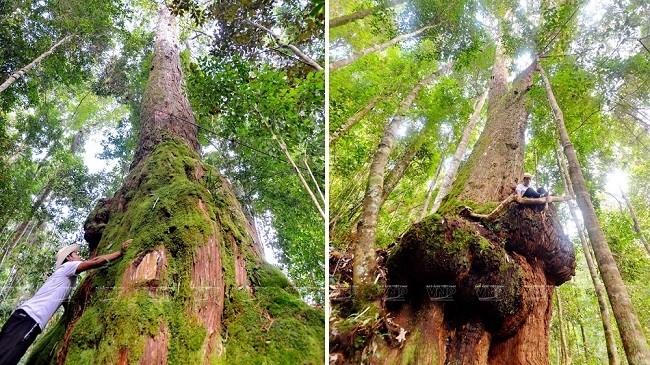According to Colonel Duong De Chau, Head of the Axan Border Post in Axan commune, Tay Giang district, who accompanied us during the trip, Tay Giang shares a border line with Kalum district, in the Sekong province of Laos. Since last year, local border guards have stepped up their efforts to prevent illegal migration and prevent the spread of COVID-19.
However, for every rule, there is an exception. Chau recalled a recent incident when a pregnant Laotian women suffered from prolonged and difficult labour and her family asked for help from the Vietnamese border guards. She oughtn’t to have been allowed to enter Vietnam amid COVID-19, but was granted the privilege because it was an emergency.
In a timely manner, Chau called an ambulance from Tay Giang district’s hospital while sending border guards to cross the forest and transport the pregnant woman to a place closest to the road to the hospital.
With the help of Vietnamese doctors, that afternoon, the mother had a healthy baby. After being discharged from the hospital, the mother and child had to do a 14-day mandatory quarantine before they could return to her house, as did the border soldiers who had made contact with the mother.
“At work, we treat people equally regardless of whether they are Vietnamese or Laotian,” Chau stressed, adding that whenever the area receives gift packages after being hit by storms and floods, they are delivered equally to people living in the border areas no matter what their nationality is.
“We must count on people in border protection. And forest protection, too,” Chau concluded.
In the afternoon, we arrived at the po mu eco-tourism village in Tay Giang district, built a few years ago. Nestled amidst the forest and mountains and surrounded by Zi'liang stream, the village has 11 stilt houses constructed in the traditional architectural style of the Co Tu ethnic group.
 |
The po mu eco-tourism village has 11 stilt houses constructed in the traditional architectural style of the Co Tu ethnic group.
A middle-aged man brought us to the guest houses. He was elder Hoih' Mia, the head of the village. The 54-year-old man was the former party secretary of Ganil village and he has worked as head of the po mu eco-tourism village since 2017.
Truong Duc Viet, Deputy Head of the Axan border post told us that the village welcomed many tourists before COVID-19. Visitors to the village can join in activities to experience the Co Tu ethnic culture such as drumming, gong playing and dancing or competing in folk games, including playing quoits and pouring water into bamboo pipes. They are also introduced to the traditional rituals and ceremonies of the Co Tu people.
According to elder Hoih' Mia, the po mu forest covers the two communes of Tr’hy and Axan, which have a population of 300 in total, all belonging to the Co Tu ethnic group.
The core area of the forest covers 450 hectares, protected by local people. The Co Tu ethnic people consider the forest as their mother and relative. The po mu forest in particular is even more sacred to them, as it is a time-honoured treasure, a kingdom that protects the villagers. Thus they feel guilty if they don’t protect the forests. Those who destroy the forests are severely punished according to the law and village rules.
Local people set up self-managed groups for forest protection. Thanks to their operation, the forestry in this area has been very well protected and preserved.
The po mu forest in Tay Giang district is considered the oldest and largest population of po mu trees in in Vietnam. It is home to a total of 2,011 trees, 1,146 of which are recognised as heritage trees.
The oldest one is 1,800 years old while the largest is 1,328 years old with a diameter of 3.5 metres and circumference of 11 metres.
 |
An ancient po mu tree with its trunk protrudes a huge hump like a tiger's head. (Photo: Vietnam Pictorial)
All of the po mu trees in the forest are numbered and named according to their size and root shape, such as Me (Mother), Ngu Ho (Five Tigers), Rong (Dragon), Voi (Elephant), and Khi (Monkey).
It took elder Hoih’ Mia and local officials and rangers more than two months to trek in the forest and complete the numbering of over 2,000 po mu trees.
In early morning the next day, we had a trek into the forest where time has covered the ground with thick layers of leaves, forming a giant soft cushion under the feet.
While wandering in the forest, we were startled by a gigantic tree which trunk looks like a monster sitting in the ground. It turned out that this was a po mu tree named ‘gu Ho. The diameter of the tree is about 7-8 metres, its height is over 20 metres while its trunk protrudes a huge hump like a tiger's head, and several smaller humps like a tiger’s body and front legs.
Trekking a little further we encountered the ‘Dragon’ tree and many other ancient po mu trees in various, extraordinary shapes created by Mother Nature.
Ending the trek, elder Hoih' Mia showed us a signal board installed on the roadside, which reads "Please take nothing but pictures. Leave nothing but footprints”. It is also the message that Co Tu people want to send to visitors to the forest in a joint effort to keep their po mu forest evergreen forever.
















